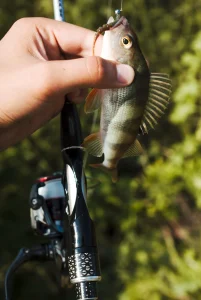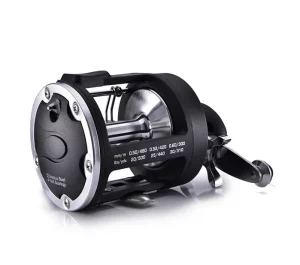
To reel in a large fish with success, good planning and skillful moves are vital. Pick a sturdy rod and a strong line type—medium-hard or hard rods paired with braided or fluorocarbon lines suit big fish best. Spot bites using a rod with a sensitive end and set the hook strongly based on the fish type and water conditions. Keep steady force with a well-set drag, holding the rod at a 45-degree tilt during the struggle. Use the pump-and-reel method to save strength, avoid loose lines, and stop tangles. Gently lead the fish to the water’s surface, handle it with care, and have tools ready for release or keeping it. Top-notch gear, like Laike’s high-quality reels and rods, boosts control and helps land big catches.
How Should You Prepare for Reeling in a Large Fish?
Why Matching Rod Strength with Your Target Species Matters More Than You Think
Before you toss your line, reeling in a large fish depends a lot on choosing the right rod. A rod too weak can’t handle a strong fish. A rod too stiff might break lighter lines or pull the hook out of fish with soft mouths. Medium-hard to hard rods work well for bigger freshwater or saltwater fish. They give the power and bend needed for long fights. Suggested gear includes a spinning reel or lure reel, medium, medium-hard, or hard fishing rods, and lines with 6-20 pounds of pulling strength.
Which Line Type Is Best for Handling Heavyweights?
Your line is your connection to the fish. Braided lines are liked for their toughness and low stretch. This gives you a better feel and control in long battles. Fluorocarbon leader lines are also great because they resist scrapes and are nearly invisible underwater. Line choices include braided, monofilament nylon, fluorocarbon leader, and steel wire leader lines. Setting the right tension is key. Too tight, and the line might snap. Too loose, and the hook won’t stick well.
How Can You Recognize When a Big Fish Strikes?
Why Sensitive Rod Tips and Bite Indicators Are Crucial
Big fish don’t always hit hard. Sometimes, they nibble lightly before biting fully. A rod with a sensitive tip lets you feel even tiny movements. Bite indicators help too. They show changes in line tension or movement clearly.
When Is the Right Time to Set the Hook?
Timing is super important. Pull too early, and you’ll miss the fish. Wait too long, and it might spit out the bait. Feel for steady pulling or movement before setting the hook with a smooth, firm tug.
What’s the Most Effective Way to Set the Hook?
How Do You Drive a Hook into Tough Mouths Without Tearing It Out?
Big fish like bass or pike have hard jaws that need a strong hookset. Use your wrist and arm together for a quick, upward jerk of the rod. Keep tension on the reel. This drives the hook in without using too much force.
Does Hookset Force Vary by Species or Conditions?
Yes, it does. A trout with a soft mouth needs a light flick. A tough catfish needs a stronger pull. Water clarity, current speed, and bait type also change how much force you should use.
How Do You Maintain Pressure Without Breaking Your Line?
Why Drag Settings Are Your Best Friend Against Line Breakage
A well-set drag system takes in sudden bursts of energy from big fish. Adjust the drag device on your fishing reel to match the hook’s strength. This wears out the fish fast and prevents line breaks. It keeps steady pressure during the fight.
How Should You Position Your Rod During a Fight?
Hold your rod at about a 45-degree angle from the water. Too high, and you lose power. Too low, and the line might go slack. Adjust based on how hard the fish fights or if it changes direction.
Can You Read Fish Behavior While Reeling In?
What Do Runs, Rolls, and Direction Changes Tell You?
When a fish swims fast away, it’s trying to escape. Let it run, but keep the drag tight. Rolls show the fish is tired or confused. Reel steadily to gain ground. Quick direction changes need fast reactions to avoid slack.
How Should You Adapt Based on Species Behavior?
Some fish, like carp, make long runs. Others, like bass, might leap out of the water. Change your reeling speed and rod angle to match their moves and stay in control.
What’s an Efficient Pump-and-Reel Technique Look Like?
How Do You Synchronize Rod Lifts with Reel Cranks?
The pump-and-reel method means lifting your rod up to pull the fish closer. Then lower it while reeling in the loose line fast. This steady rhythm saves your energy and keeps pressure on the fish. It’s key for long battles with big fish.
Why Does Energy Conservation Matter During Long Fights?
Fighting a big fish can take many minutes, especially in strong currents. Using efficient moves helps you stay strong and focused when it’s time to land the fish.
What Mistakes Should You Avoid During Retrieval?
Why Is Slack Line So Dangerous When Fighting Big Fish?
A loose line lets the fish shake free or the hook fall out. Always keep a little tension on the line, even when shifting your grip or moving your gear.
How Can You Prevent Mid-Fight Line Twists and Tangles?
Don’t reel too fast when you’re not gaining ground. This builds up twists in the line. Let the drag system work instead of forcing the reel too hard.
How Do You Bring Big Fish Up Without Losing Them at The Surface?
What’s Better: Guiding or Forcing A Fish Upwards?
Guide the fish gently with steady pressure. Don’t yank it up fast. This reduces stress on your gear and the fish. Let tired fish come to the surface on their own before netting them smoothly.
How Can Both Angler And Fish Stay Safe During This Phase?
Use rubberized nets to avoid hurting the fish. They also make landing quicker. Don’t lift big fish by their jaw alone. Support their body evenly, especially if you plan to release them.
What Steps Secure Your Catch Once It’s Landed?
Which Handling Techniques Prevent Injury Or Escape After Landing?
Handle fish with wet hands or gloves to protect their slime coat. This keeps them healthy if you release them. Hold them flat, not dangling, to avoid hurting their insides.
What Should Be Ready Whether Releasing Or Storing Your Catch?
Have pliers ready to remove hooks fast. For releasing, hold the fish gently in water until it swims away strongly. For keeping, use a cooler with ice packs right after humanely dispatching the fish.
How Can Laike Products Elevate Every Stage of Your Fishing Workflow?

Laike provides top-quality fishing gear made for anglers chasing big catches in all kinds of waters, from calm lakes to rough seas. Laike’s Fishing Reels Manufacturer – Trolling/Spinning/Baitcast offers strong spinning reels with high-carbon metal bodies. These ensure smooth work even under heavy loads. Their precision transmission system allows easy line reeling with less resistance.
Their gear includes fishing reels for every situation, like baitcasting for ocean predators or spinning reels for gentle freshwater fishing. Laike’s rods are built to spread weight evenly during fights. For a great setup, pair a medium-hard spinning rod with a Laike carbon-brake spinning reel. Add a braided mainline and fluorocarbon leader for flexibility across fish types without losing control.
Whether you’re aiming for deep-water giants with jigs that mimic crayfish or using VIB lures that sink and twitch along the bottom, Laike’s gear works together perfectly. This lets you focus on your skills, not worry about weak equipment.
FAQs
Q1: What should I do if my reel starts making noise during retrieval?
A: Stop reeling right away. Noises might mean gears are misaligned or dirt is in the spool. Clean your reel well after each trip and check bearings often.
Q2: Is braided line always better than monofilament?
A: Not always—it depends on the situation. Braided lines are strong but don’t absorb shock well. Monofilament stretches, which helps with fish that have softer mouths.
Q3: Can I use my spinning reel setup in both saltwater and freshwater?
A: Yes, you can. But rinse it well after saltwater trips to stop rust, unless it’s a sealed model like many of Laike’s high-quality reels.




